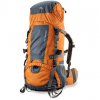I noticed that several people have mentioned torso length. I have also noticed on line that a lot of these packs are adjustable from xx-xx. Is that a solid assessment to follow that they will adjust to the frame?
Yes. Not all packs are made this way. Some brands make their packs to fit a specific torso range, small, medium and large. My MAX65L has multiple attachment points for the shoulder harness system and you can set it to fit yourself. It is easy to change if you get it wrong or you loan the pack to a friend or sell it.
Modern packs have a lot of details included or omitted that we haven't mentioned, but can increase a pack's utility or make it heavy and overly complicated.
Floating top compartment: This means that you can remove the top compartment altogether and leave it at home for a smaller pack and weight savings, or remove it in camp and use it as a daypack. Top compartments usually have one or two small zip closures and fit maps, thin raingear, pack rain cover and small tarp.
Packs with this type top compartment usually have a spindrift collar on the top of the bottom compartment for closure when not using the floating top compartment. The spindrift collar is like the top six to eight inches of a nylon drawstring bag with a cordlock on it. Extended, it can add six to eight inches of height/capacity to the pack. Cinched tight, it helps to seal out weather, blown sand, rain or snow (spindrift).
Compression straps: Many packs have side, top and bottom compression straps. They help to tighten the loaded pack to prevent shifting of contents, and can be used to reduce the pack volume.
Daisy Chain: These are a series of loops down the back of the pack that give you attachment points to strap on gear externally, such as a coat or foam sleeping pad.
Hip belt pockets: These are small zip closure pockets on one side or both of the hip belt, usually easier to reach than any of the main pack pockets while the pack is still on. Great for small lightweight items such as snacks, compass or camera.
Internal Shelf: Some packs have an interior divider between the bottom of the pack and the main compartment. The bottom compartment is usually accessed from the lower rear panel via an external zipper. This lets you remove whatever is there (coat, sleeping bag, shelter) without unloading the contents in the upper pack. Many of these dividers will zip open internally to give you the option of not using the divider, or accessing the lower compartment from the top when the upper compartment is empty.
Hydration Compatable: Many newer packs are designed with an internal pocket next to the internal or external frame to fit and suspend a two liter water bladder. Most do not include the bladder itself, but they do have either one or two weather-resistant ports at the top of thepack to route the hydration hose down a shoulder strap so that you can drink on the go.
Side Pockets: Some packs have two or even four zip closure side pockets. I like them personally. They hold a lot of small odds and ends that would be hard to sort and find in the larger main pack compartment. I keep firestarting, lighting, first aid and such on one side, snacks, TP, maps, notebook and pen, and other small items on the other side. Mesh side pockets are good for holding water bottles, particularly if they include a cinch strap to keep the bottle from falling out on the trail.
Ice Ax Loops: These are loops on the rear bottom of the pack that are meant to hold an ice ax on the back of the pack. They work equally well to hold trekking poles, a photography tripod, fishing rod or other bulky gear.
Rain Cover: Not all manufacturers include a rain cover, however they can be purchases as an accessory item at extra cost. Some people prefer to use a waterproof pack liner, or individual waterproof stuff bags for their gear.
Frames: Internal frames vary widely in how they are made. The best, IMHO, are HDPE sheets with twin aluminum stays. The stays can be bent to fit your back, and help transfer the weight of the bpack to the hip belt.
I've never tried a frameles pack such as the GOlites, but it seems like they would work well with a load of 20# or less.
External frames come in a wide variety also. This is what I used in the late '60's and early '70's. They were all we had then and they were sometimes torture devices. They also squeeked when they flexed. Designs have come a long way since then though. One of their best plus's is that they hold the pack away from your back for better air circulation.
Weighing it all: I tried various scales and what I wound up with was a hanging digital fish scale for about $20. It is accurate and will weigh up to 50#.
On pack sizing: Remember that you make a bigger pack smaller by cinching it down, but you can't make a small pack bigger without hanging crap off of it until you look like a walking yard sale. There is always the temptation to fill a pack to it's capacity, regardless of size, but with some experience comes self control.
My 36# pack just went on a 16 mile (round trip) overnighter to shakedown it's contents, and I will be adding a few ounces of gear, and deleting a few pounds. Next time my goal is 25# or less including food and water.

